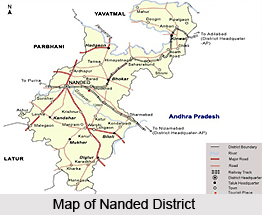 Administration of Nanded district has at its very centre the District Collector. He is the pivot on which the district administration turns. Not only is he the head of the Revenue department in the district but, in so far as the needs and exigencies, of district administration are concerned, he is expected to superintend the working of the offices of other departments. He has to perform multifarious duties and functions. Broadly speaking, the various duties and functions of the Collector include - Revenue functions, Land Revenue Collections, taking care of Inams and Jagirs, Public Utility, Accounts, Quasi-judicial functions in revenue matters, Local Self Government, Municipality, as District Magistrate, as District Registrar, Sanitation and Public Health, District Soldiers`, Sailors` and Airmen`s Board as well as functions relating to the running of the Zilla Parishad and Panchayat Samities.
Administration of Nanded district has at its very centre the District Collector. He is the pivot on which the district administration turns. Not only is he the head of the Revenue department in the district but, in so far as the needs and exigencies, of district administration are concerned, he is expected to superintend the working of the offices of other departments. He has to perform multifarious duties and functions. Broadly speaking, the various duties and functions of the Collector include - Revenue functions, Land Revenue Collections, taking care of Inams and Jagirs, Public Utility, Accounts, Quasi-judicial functions in revenue matters, Local Self Government, Municipality, as District Magistrate, as District Registrar, Sanitation and Public Health, District Soldiers`, Sailors` and Airmen`s Board as well as functions relating to the running of the Zilla Parishad and Panchayat Samities.
The Collector`s Office
The Collector`s office at Nanded is divided into many branches, such as Chitnis branch, Accounts branch, Endowment branch etc, each of which is usually in charge of a person in the grade of a Mamlatdar.
Prant Officers
Under the Collector are the Prant Officers who are either Assistant Collectors (Indian Administrative Service) or District Deputy Collectors (Maharashtra Civil Service). The two sub-divisions of the Nanded district are under the charge of a Prant Officer each with headquarters at Nanded and Deglur, respectively. The Prant Officers form the connecting link between the Tahsildar and the Collector. A Prant Officer exercises all the powers conferred on the Collector by the Land Revenue Code and by any other law in force or by executive orders, in regard to the tahsil and mahals in his charge, except such powers as the Collector may specially reserve to himself. His principal functions in regard to his sub-division relate to Revenue and Magisterial matters as well as certain other duties, such as informing the collector about the work going on at d subdivision, forest settlement work etc.
Tahsildars and Naib-Tahsildars
The Tahsildar is the officer in executive charge of a tahsil and the Naib-Tahsildar has the executive charge of a mahal. There is a sub-treasury in every tahsil or mahal, and there is practically no difference of any kind between the functions and duties of a Tahsildar and those of a Naib-Tahsildar. A Tahsildar and Naib-Tahsildar are assisted by the head clerks (awal karkuns) and his assistants in the office and the Circle Officer and Circle Inspectors in the field. The duties of Tahsildars and Naib Tahsildars fall under various heads. These include Revenue, Quasi-judicial, Magisterial, Treasury and Accounts matters along with other administrative duties.
Circle Officers and Circle Inspectors
In order to assist the Tahsildar in exercising proper supervision over the village officers and village servants and to make local enquiries of every kind promptly, Circle Officers in the grade of awal karkuns and Circle Inspectors in the grade of karkuns are appointed. The Circle Officer certifies the Record-of-Rights, and thus relieves the Tahsildar of a good deal of routine work. There are between 30 to 50 vil1ages in charge of a Circle Officer or Circle Inspector. These officers form a link between the Tahsildar and the village officers. There is generally one Circle Officer and one Circle Inspector in each tahsil.
Patils
The patil is the principal official in a village. The duties of the patil fall under the following heads: revenue quasi, magisterial and administrative.
Talathi and Assistant Gramsevaks
With effect, from July 1, 1960 all kulkarni watans along with the right of service were abolished, under the Hyderabad Abolition of Inams and Cash Grants Act, 1954 amended by the Bombay (Amendment) Act No. LXIV of 1959. Now stipendiary talathis are appointed. If the villages are small one talathi is appointed for two or more villages, which are said to be his charge or saza. With effect from January 1, 1963 the establishment of talathis was transferred to the Zilla Parishad consequent upon the abolition of watan of revenue patils and transfer of the functions of collection of land revenue and maintenance of agricultural statistics in the village panchayats. However, their services have been re-transferred to the Government. As far as Record of Rights is concerned, he is directly under the control of the revenue officers.
Village Servants
In addition to the village officers mentioned above there were hereditary village servants such as ramoshi, jagalyas, set sindhis, etc. The watans of these hereditary village servants were abolished under the Bombay Inferior Village Watans Abolition Act, 1958. After the abolition of the hereditary village servants, the system of stipendiary kotwals and recruitment and employments of kotwals was regulated. Now there is one kotwal for a village having a population of not more than 500, two if the population is between 501 and 2,000 and three in case the population exceeds 2.000. The first category of kotwals gets a monthly payment of Rs.20 while the next two receive Rs.30 per month.
Thus discussed is the administrative structure of the district of Nanded.



















